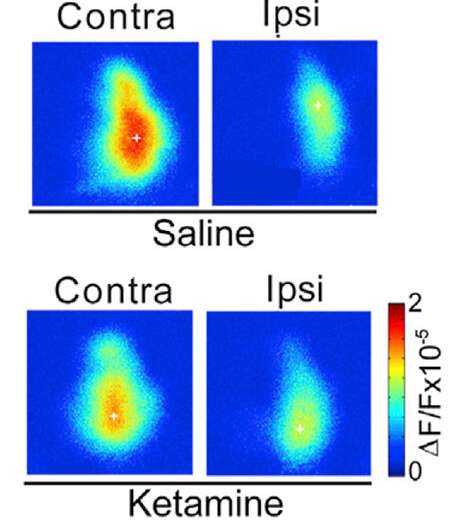New study finds antidepressant drug effective in treating 'lazy eye' in adults

In a new study, published in Current Biology, researchers from the University of California, Irvine School of Medicine reveal how subanesthetic ketamine, which is used for pain management and as an antidepressant in humans, is effective in treating adult amblyopia, a brain disorder commonly known as 'lazy eye.'
"Our study demonstrates how a single-dose of subanesthetic ketamine reactivates adult visual cortical plasticity and promotes functional recovery of visual acuity defects resulting from amblyopia," explained Xiangmin Xu, Ph.D., a professor of anatomy and neurobiology and director of the Center for Neural Circuit Mapping at the UCI School of Medicine.
Subanesthetic ketamine, commonly used to treat depression and pain, evokes rapid and long-lasting antidepressant effects in human patients. There was evidence that ketamine may control how the nervous system makes structural changes in response to internal and external demands, a process called neural plasticity. But, how the drug worked remained elusive, until now.
"Our research team showed that ketamine down-regulates NRG1 expression in PV inhibitory cells, resulting in sustained cortical disinhibition to enhance cortical plasticity in adult visual cortex," said Steven F. Grieco, Ph.D., a postdoctoral scholar in the Xu lab and lead author.
"Through this neural plasticity-based mechanism, ketamine mediated functional recovery from adult amblyopia." Xin Qiao, Ph.D., a postdoctoral staff in the Xu lab is a co-first author for the published paper.
Amblyopia is a vision disorder in which the brain fails to process inputs from one eye, favoring the other eye. The condition can result in decreased vision in the affected eye. Each year, between one and five percent of children worldwide, are diagnosed with this condition.
Fast and sustained ketamine actions show promise for therapeutic applications that rely on reactivating adult cortical plasticity. Further testing is needed to determine the full implications of this discovery.
More information: Steven F. Grieco et al, Subanesthetic Ketamine Reactivates Adult Cortical Plasticity to Restore Vision from Amblyopia, Current Biology (2020). DOI: 10.1016/j.cub.2020.07.008

















